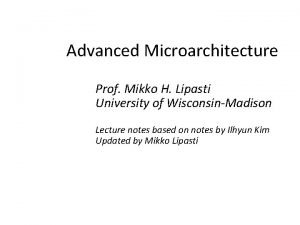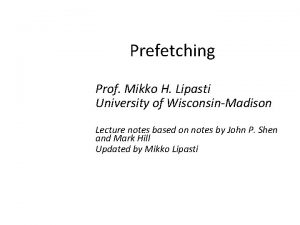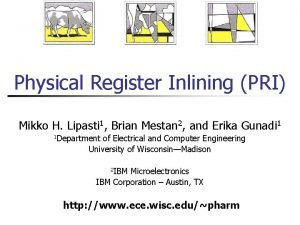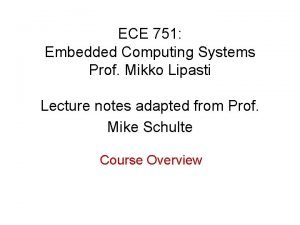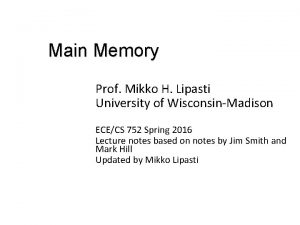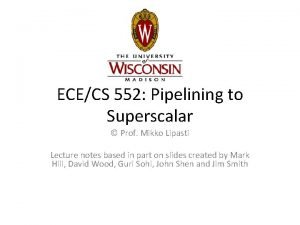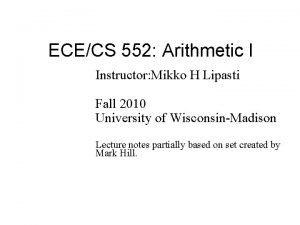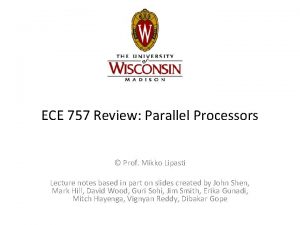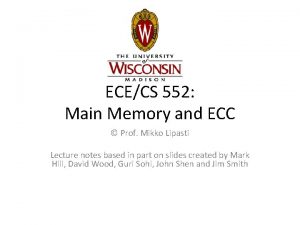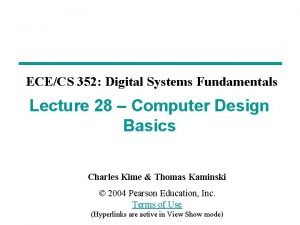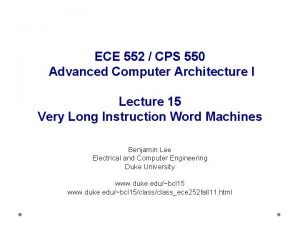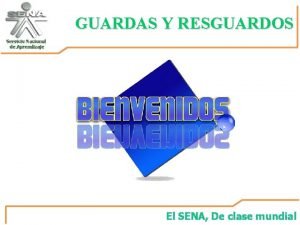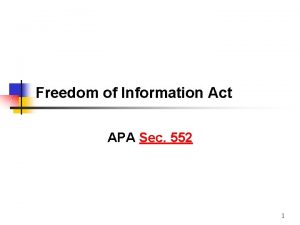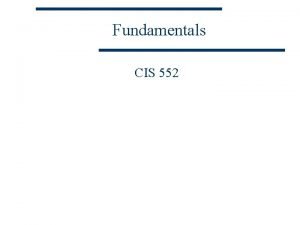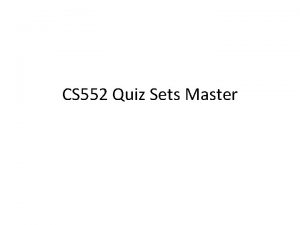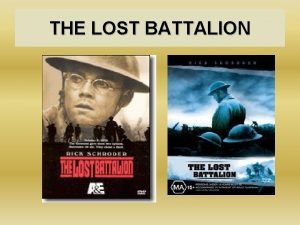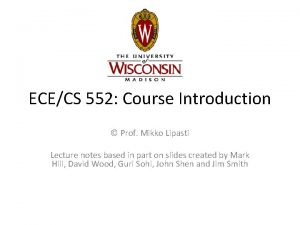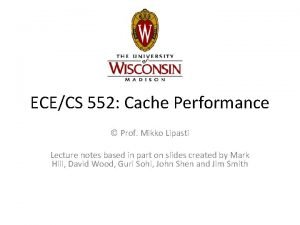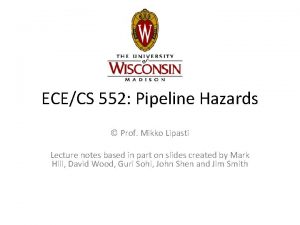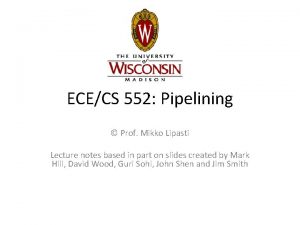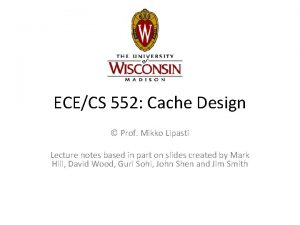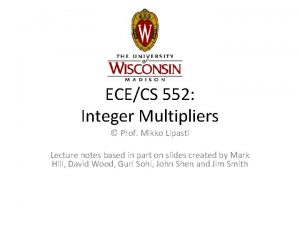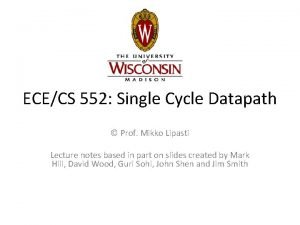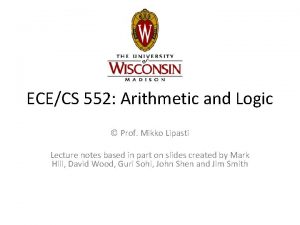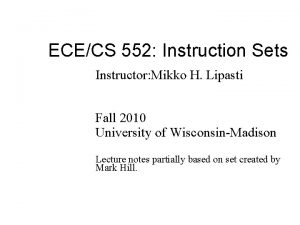ECECS 552 Course Introduction Prof Mikko Lipasti Lecture

![Computer Architecture Instruction Set Architecture (IBM 360) • … the attributes of a [computing] Computer Architecture Instruction Set Architecture (IBM 360) • … the attributes of a [computing]](https://slidetodoc.com/presentation_image_h2/d5704d4f9adad2fc5e0ed08219acb257/image-2.jpg)






![Performance Growth Unmatched by any other industry ! [John Crawford, Intel] • Doubling every Performance Growth Unmatched by any other industry ! [John Crawford, Intel] • Doubling every](https://slidetodoc.com/presentation_image_h2/d5704d4f9adad2fc5e0ed08219acb257/image-9.jpg)












- Slides: 21

ECE/CS 552: Course Introduction © Prof. Mikko Lipasti Lecture notes based in part on slides created by Mark Hill, David Wood, Guri Sohi, John Shen and Jim Smith
![Computer Architecture Instruction Set Architecture IBM 360 the attributes of a computing Computer Architecture Instruction Set Architecture (IBM 360) • … the attributes of a [computing]](https://slidetodoc.com/presentation_image_h2/d5704d4f9adad2fc5e0ed08219acb257/image-2.jpg)
Computer Architecture Instruction Set Architecture (IBM 360) • … the attributes of a [computing] system as seen by the programmer. I. e. the conceptual structure and functional behavior, as distinct from the organization of the data flows and controls, the logic design, and the physical implementation. -- Amdahl, Blaauw, & Brooks, 1964 Machine Organization (microarchitecture) • ALUS, Buses, Caches, Memories, etc. Machine Implementation (realization) • Gates, cells, transistors, wires 2

552 In Context • Prerequisites – 252/352 – gates, logic, memory, organization – 252/354 – high-level language down to machine language interface or instruction set architecture (ISA) • This course – 552 – puts it all together – Implement the logic that provides ISA interface – Must do datapath and control, but no magic – Manage tremendous complexity with abstraction • Follow-on courses explore trade-offs – ECE 752, ECE 555/ECE 755, ECE 757 3

Why Take 552? • To become a computer designer – Alumni of this class helped design your computer • To learn what is under the hood of a computer – – Innate curiosity To better understand when things break To write better code/applications To write better system software (O/S, compiler, etc. ) • Because it is intellectually fascinating! – CPUs are arguably the most complex highly-integrated man-made devices 4

Abstraction and Complexity • Abstraction helps us manage complexity • Complex interfaces – Specify what to do – Hide details of how l Goal: remove magic Application Program CS 302 Operating System Scope of this course Compiler CS 537 CS 536 Machine Language (ISA) CS 354 Digital Logic ECE 352 Electronic circuits ECE 340 Semiconductor devices ECE 335 5

Computer Architecture • Exercise in engineering tradeoff analysis – Find the fastest/cheapest/power-efficient/etc. solution – Optimization problem with 100 s of variables • All the variables are changing – At non-uniform rates – With inflection points – Only one guarantee: Today’s right answer will be wrong tomorrow • Two high-level effects: – Technology push – Application Pull 6

Technology Push • What do these two intervals have in common? – 1776 -1999 (224 years) – 2000 -2001 (2 years) l Answer: Equal progress in processor speed! l The power of exponential growth! Driven by Moore’s Law l – Device per chips doubles every 18 -24 months l Computer architects work to turn the additional resources into speed/power savings/functionality! 7

Some History Date Event Comments 1939 First digital computer John Atanasoff (UW Ph. D ’ 30) 1947 1 st transistor Bell Labs 1958 1 st IC Jack Kilby (MSEE ’ 50) @TI Winner of 2000 Nobel prize 1971 1 st microprocessor Intel 1974 Intel 4004 2300 transistors 1978 Intel 8086 29 K transistors 1989 Intel 80486 1. M transistors, pipelined 1995 Intel Pentium Pro 5. 5 M transistors 2005 Intel Montecito 1 B transistors 8
![Performance Growth Unmatched by any other industry John Crawford Intel Doubling every Performance Growth Unmatched by any other industry ! [John Crawford, Intel] • Doubling every](https://slidetodoc.com/presentation_image_h2/d5704d4f9adad2fc5e0ed08219acb257/image-9.jpg)
Performance Growth Unmatched by any other industry ! [John Crawford, Intel] • Doubling every 18 months (1982 -1996): 800 x – Cars travel at 44, 000 mph and get 16, 000 mpg – Air travel: LA to NY in 22 seconds (MACH 800) – Wheat yield: 80, 000 bushels per acre l Doubling every 24 months (1971 -1996): 9, 000 x – Cars travel at 600, 000 mph, get 150, 000 mpg – Air travel: LA to NY in 2 seconds (MACH 9, 000) – Wheat yield: 900, 000 bushels per acre 9

Technology Push • Technology advances at varying rates – E. g. DRAM capacity increases at 60%/year – But DRAM speed only improves 10%/year – Creates gap with processor frequency! • Inflection points – Crossover causes rapid change – E. g. enough devices for multicore processor (2001) • Current issues causing an “inflection point” – Power consumption – Reliability – Variability 10

Application Pull • Corollary to Moore’s Law: Cost halves every two years In a decade you can buy a computer for less than its sales tax today. –Jim Gray • Computers cost-effective for – – – National security – weapons design Enterprise computing – banking Departmental computing – computer-aided design Personal computer – spreadsheets, email, web Mobile computing – smartphones 11

Application Pull • What about the future? • Must dream up applications that are not costeffective today – – Virtual reality Telepresence Mobile applications Sensing, analyzing, actuating in real-world environments • This is your job! 12

Abstraction • Difference between interface and implementation – Interface: WHAT something does – Implementation: HOW it does so 13

Abstraction, E. g. • 2: 1 Mux (352) • Interface X Y S Mux S 0 1 F X Y F • Implementations – Gates (fast or slow), pass transistors 14

What’s the Big Deal? Firefox, MS Excel • Tower of abstraction • Complex interfaces implemented by layers below • Abstraction hides detail • Hundreds of engineers build one product • Complexity unmanageable otherwise Windows 7 Visual C++ x 86 Machine Primitives Von Neumann Machine Logic Gates & Memory Transistors & Devices Quantum Physics 15

Basic Division of Hardware • In space (vs. time) Output Control Data path Processor Memory Input 16

Basic Division of Hardware • In time (vs. space) – Fetch instruction from memory add r 1, r 2, r 3 – Decode the instruction – what does this mean? – Read input operands read r 2, r 3 – Perform operation add – Write results write to r 1 – Determine the next instruction pc : = pc + 4 17

Building Computer Chips • Complex multi-step process – Slice silicon ingots into wafers – Process wafers into patterned wafers – Dice patterned wafers into dies – Test dies, select good dies – Bond to package – Test parts – Ship to customers and make money 18

Building Computer Chips 19

Performance vs. Design Time • Time to market is critically important • E. g. , a new design may take 3 years – It will be 3 times faster – But if technology improves 50%/year – In 3 years 1. 53 = 3. 38 – So the new design is worse! (unless it also employs new technology) 20

Summary The ART and Science of Instruction-Set Processor Design [Gerrit Blaauw & Fred Brooks, 1981] • CPU designers must know BOTH software and hardware • Both contribute to layers of abstraction • IC costs, design time and performance 21
